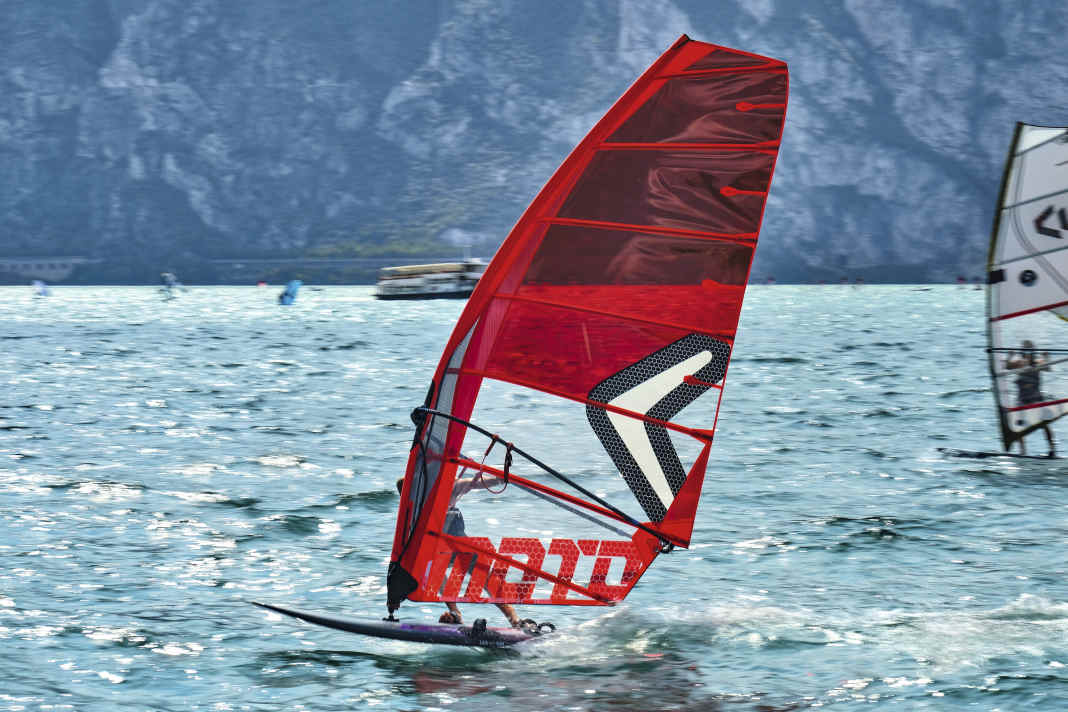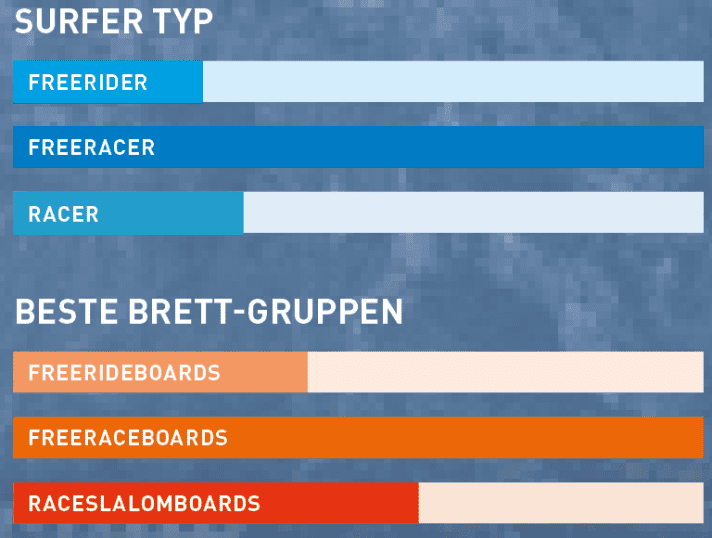





These freerace sails are included in the test:
Freerace sails probably offer the best compromise for approaching your personal top speed without suffering the disadvantages of mostly heavy racing sails. Even with a slightly narrower mast sleeve and a little less loose leech, the sails offer such good controllability and such great speed potential that for most surfers only their own ability defines the sound barrier for the time being. Race sails, on the other hand, are not only significantly more expensive, but also more cumbersome to set up and more energy-intensive at the water start and during manoeuvres. Before finally reaching for a pure race sail, it is better to get a faster fin or a slalom raceboard - tuning measures that allow more speed without necessarily having any disadvantages, because a fast carbon fin and a good slalom raceboard can even be easier to control than a poorly trimmed freerace board.

Freerace sail equipment
Without exception, the freerace sails tested belong to the high-quality model lines of the brands and are therefore not stingy with features. In addition, the test sails all impress with their solidly dimensioned mono film. Intermittent attempts by individual brands to save weight with wafer-thin crackle film have obviously been abandoned. The top caps are either made of robust plastic or reinforced accordingly, and the batten ends are protected on both sides. With the exception of Neil-Pryde, the designers have provided abrasion protection on the diagonal batten. However, the V8 does not touch in normal trim.
A Severne Moto, on the other hand, is certainly surfed more often with the outhaul loosely attached and the profile in contact with the boom. What the Moto lacks is a visual trim mark. The other sails have trim points in the sail and the Duotone also has a small window in the mast sleeve through which you can see how far the sail has been trimmed over the lower edge of the mast - Ezzy surfers are familiar with a similar principle. A Velcro adjustable marker even "saves" your favourite trim. The NeilPryde sail should only be pulled all the way to the last trim point in stormy conditions, whereas the max trim has established itself as the standard setup for the GA during testing. The Duotone sail offers a particularly wide range of trim options and also changes most noticeably depending on the wind strength.
Numerous other Detailed photos are shown in a separate article as well as in the individual ratings of the tested models!
I wouldn't have thought that a sail with a 460 RDM mast could be so tight." (Nicholas Slijk, surf tester)
Setting up sails with cambers
Once you have internalised the correct sequence, you can set up your camber sail almost as quickly as a NoCam:
- Thread the mast above the camber
- Enforce luff
- Attach boom
- Tension outhaul
- Loosen the luff a little again
- Folding the camber
- Close zips
- Trim the luff
- You can find a detailed guide to setting up camber sails here: Rig camber sails correctly
Ideally, you should press on the markings printed on the sail or in the mast sleeve directly on the camber to fold the profile supports. With most sails, the camber pressure against the mast can be adjusted using spacer rings; with Duotone, it can even be adjusted with the camber folded down using a sophisticated screw mechanism. The adjustment travel of this mechanism should be a little longer for the upper camber for a maximum tight fit. With the S_Pace, the appropriate luff tension must therefore be set up a little more precisely so that this camber does not pop off again before trimming if the luff tension is too low. Once trimmed and on the water, however, this never happened again. The NeilPryde camber is not adjustable, is still very tight on the mast when new and did not rotate completely straight away. "But that will definitely improve over time," says surf tester Nicholas from experience.
Severne delivers the Moto with small RDM camber, because the concept of the sail means that all sizes can be rigged on RDM masts and on a boom (160-220). The trim forces differ enormously. The NeilPryde V8 requires a lot of muscle power - or better yet, an extension like the Duotone Power.XT with ratchet. The 75 to 90 kilos of pull on Duotone, GA-Sails and Severne, on the other hand, can still be pulled conventionally. For all sails, we have indicated the maximum trim force measured with a tension scale in kilos.
All the camber works almost flawlessly. Both when rigging and unrigging as well as in the jibe. (Stephan Gölnitz, surf tester)
Which sail suits whom?
Because the differences in performance are actually quite small, subjective perception could be a much stronger deciding factor for some surfers. Damped or direct? Rather very powerful and with power on the back hand? Or would you prefer a neutral balance with less acceleration options by pulling with the back hand? With the NeilPryde V8 and the Duotone, for example, the centre of effort feels a little further back and up. This makes these sails appear somewhat larger, but conversely offers a lot of potential for maximum performance, especially in light winds and on upwind courses. With the Severne and GA, on the other hand, some surfers who like to control the sail power with a clear pull of the rear hand might lack a little "response" when planing and accelerating. Personal preference plays just as much a role here as body size. Smaller surfers will probably feel particularly comfortable with a Severne or GA, while taller surfers will get the necessary displacement with a V8 or S_Pace. The GunSails Vector is a special case, as its extremely calm, stable position on the board makes it very controllable - but it requires noticeably more power to manoeuvre.
Driving characteristics in comparison






The freerace sails in the individual evaluation
Click to go to the test reports

